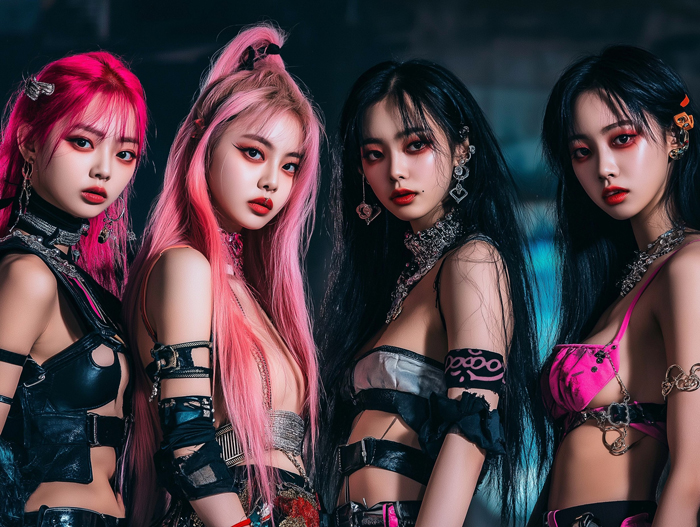K-pop, short for Korean pop, has grown from a niche genre in South Korea to a global phenomenon that dominates charts, trends, and cultural conversations around the world. Its explosive rise in popularity is not just a passing trend, but a cultural movement that has reshaped the landscape of modern music, fashion, and entertainment. The genre, which blends elements of pop, hip-hop, R&B, and electronic music, has become a cross-cultural bridge, influencing Western pop culture and gaining millions of fans from diverse backgrounds. But how did K-pop become so popular, and what has fueled its influence on the West? In this article, we’ll explore how K-pop became a global sensation and examine its significant impact on Western pop culture.
1. The Birth of K-Pop: A Cultural and Musical Revolution
K-pop’s roots can be traced back to the early 1990s when the genre began to take shape as a fusion of traditional Korean music and Western pop influences. The early pioneers of K-pop, such as Seo Taiji and Boys, revolutionized the South Korean music scene by integrating hip-hop, rap, and American pop styles into their music. This sparked the beginning of a cultural shift, as K-pop began to blend the best elements of global music with a distinctly Korean identity.
The 1990s also saw the rise of H.O.T., one of the first K-pop boy bands to gain mainstream success. Their influence laid the foundation for the modern K-pop industry, and their popularity paved the way for the more polished and internationally appealing K-pop groups we see today. While the 1990s and early 2000s established the genre in South Korea, it was the 2010s that marked K-pop’s true global breakthrough.
2. The Role of Technology and Social Media in K-Pop’s Global Expansion
One of the driving forces behind K-pop’s global success is the rise of social media platforms, particularly YouTube. K-pop entertainment companies, such as SM Entertainment, YG Entertainment, and BigHit Entertainment (now HYBE Corporation), began uploading music videos, performances, and behind-the-scenes footage to platforms like YouTube. This allowed international fans to access K-pop content directly and contributed to the viral spread of K-pop music.
Social media also played a crucial role in cultivating K-pop fandoms, often referred to as K-pop stans. The dedicated fanbase is a key component of K-pop’s global influence, with fans around the world actively engaging with their favorite groups on Twitter, Instagram, TikTok, and fan forums. The rise of global K-pop fanbases meant that a single viral moment could spread across borders, turning a song or group into a worldwide sensation. Fans from different countries began to interact, organize, and promote their favorite artists, creating a strong sense of community that transcended language barriers.
The immense power of social media has allowed K-pop stars to build direct relationships with their fans, often through live streams, fan events, and interactive content. This level of access and engagement has created a more loyal and passionate fanbase, resulting in viral trends, global collaborations, and a constant loop of international media exposure.
3. K-Pop’s Aesthetic and Visual Appeal: A New Standard in Music Videos and Fashion
K-pop is more than just music; it’s a multi-sensory experience that combines catchy tunes, high-energy performances, and stunning visuals. The emphasis on choreography, fashion, and aesthetics has set K-pop apart from Western pop music, creating a highly stylized, immersive experience for fans.
K-pop music videos are often characterized by their extravagant sets, elaborate costumes, and intricate choreography. The “visuals” of K-pop are an integral part of the overall experience, with music videos often telling a story through elaborate cinematography and set design. The meticulous attention to detail in these productions has raised the bar for music videos globally, making K-pop a standard of creativity and artistic innovation. For example, BTS’s music video for Boy With Luv (2019) features a vibrant, candy-colored aesthetic and complex dance routines, while BLACKPINK’s Kill This Love (2019) includes sharp, high-energy choreography combined with cinematic visuals.
The influence of K-pop has also extended to fashion, with K-pop idols becoming style icons both in Korea and internationally. From the sleek, modern looks of BTS to the edgy, street-style fashion of BLACKPINK, K-pop idols regularly set trends that are followed by fans around the world. High-end brands like Chanel, Louis Vuitton, and Gucci have even collaborated with K-pop stars, helping to elevate K-pop idols into the global fashion spotlight.
K-pop has become a trendsetter in both music and fashion, influencing global audiences and making a lasting impact on Western pop culture. The unique fusion of visual spectacle and music has redefined what it means to be a pop star, pushing boundaries in both the music industry and the world of fashion.

4. K-Pop’s Cultural Exchange and the Appeal of Global Diversity
Another important aspect of K-pop’s success is its ability to create cultural exchange on a global scale. While K-pop is distinctly Korean in origin, the genre incorporates a variety of musical influences from around the world. Artists frequently blend Western genres like hip-hop, pop, and R&B with traditional Korean sounds, creating a fusion that appeals to a wide international audience. This blending of cultures has made K-pop a musical genre that transcends language and cultural barriers.
The diversity within K-pop groups also plays a role in the genre’s global appeal. Many K-pop groups feature members from different countries, such as BLACKPINK’s Lisa (Thailand), TWICE’s Sana (Japan), and NCT’s Johnny (USA). This international representation fosters a sense of inclusion and relatability for fans across the globe. The multicultural makeup of K-pop groups reflects the genre’s ability to bring together diverse cultures through music, making it more accessible and relatable to a wider audience.
Additionally, K-pop’s global influence has led to collaborations with Western artists, further increasing its reach. For instance, BTS’s collaboration with Halsey on Boy With Luv and BLACKPINK’s collaborations with Selena Gomez and Lady Gaga have introduced K-pop to Western audiences and integrated K-pop into mainstream pop culture. These collaborations have not only opened doors for K-pop but have also led to a blending of Western and Korean musical influences, creating a new hybrid genre that has expanded the global music landscape.
5. The Business of K-Pop: How Marketing and Strategic Partnerships Fuel Success
Behind the glitzy performances and viral songs lies a highly efficient and strategic business model that drives the success of K-pop. The K-pop industry is built on a meticulously planned, highly structured system that includes everything from training camps to fan engagement strategies.
K-pop entertainment companies typically scout young talent and put them through extensive training programs where they learn singing, dancing, and language skills. These “trainees” often spend years honing their craft before they are allowed to debut in a group. The system is intense, with some idols undergoing as much as 12 hours of practice a day. This rigorous training process results in idols who are not only talented performers but also highly disciplined and marketable products.
Once an idol group is ready to debut, their entertainment company uses a range of marketing tactics to ensure the group’s success. This includes releasing teaser content, using social media to engage with fans, and creating a global brand around the group. K-pop companies also rely heavily on fan culture, with fans organizing events and creating fan art to promote their idols. The loyalty of K-pop fans, known as stan culture, is a powerful force in driving the commercial success of K-pop groups. This fan-driven approach has contributed significantly to the genre’s global success, as it fosters a dedicated and passionate community that helps fuel the momentum of each new release.
6. K-Pop’s Influence on Western Pop Culture: The Mainstream Takeover
K-pop’s influence on Western pop culture has been nothing short of transformative. What was once a niche genre has now permeated mainstream pop culture, with K-pop idols appearing on international award shows, global magazine covers, and even major film productions. The genre has had a profound impact on the music charts, with groups like BTS and BLACKPINK breaking records in the West, including their dominance on the Billboard Hot 100.
One of the most significant signs of K-pop’s influence in the West is the increasing presence of K-pop idols in the global fashion industry. High-end brands are now collaborating with K-pop stars, and music videos are more likely to feature global designers. K-pop’s cross-cultural appeal has led to the formation of major brand partnerships, making K-pop not only a musical phenomenon but also a driving force in fashion, advertising, and popular media.
Additionally, K-pop’s influence has been felt in the world of entertainment, with TV shows, documentaries, and films centered around K-pop culture gaining traction in Western markets. For instance, Netflix’s Blackpink: Light Up the Sky documentary gave a behind-the-scenes look into the global success of one of K-pop’s biggest groups, shedding light on the hard work and sacrifices involved in becoming a global star. The success of this documentary is a testament to the growing curiosity and interest in K-pop culture in Western audiences.
Conclusion: K-Pop’s Enduring Global Impact
K-pop’s meteoric rise from South Korea to the global stage is a testament to the genre’s universal appeal and its ability to transcend cultural boundaries. Through a combination of innovative music, strategic marketing, social media engagement, and cultural exchange, K-pop has reshaped the global music industry and influenced Western pop culture in profound ways. With its fusion of diverse musical styles, visually stunning performances, and a passionate, loyal fanbase, K-pop has become more than just a genre—it’s a cultural movement that continues to leave its mark on the entertainment industry worldwide. As K-pop continues to gain global prominence, it will undoubtedly shape the future of music, fashion, and pop culture for years to come.
How K-Pop Became a Global Phenomenon and Its Influence on Western Pop Culture
386
previous post




